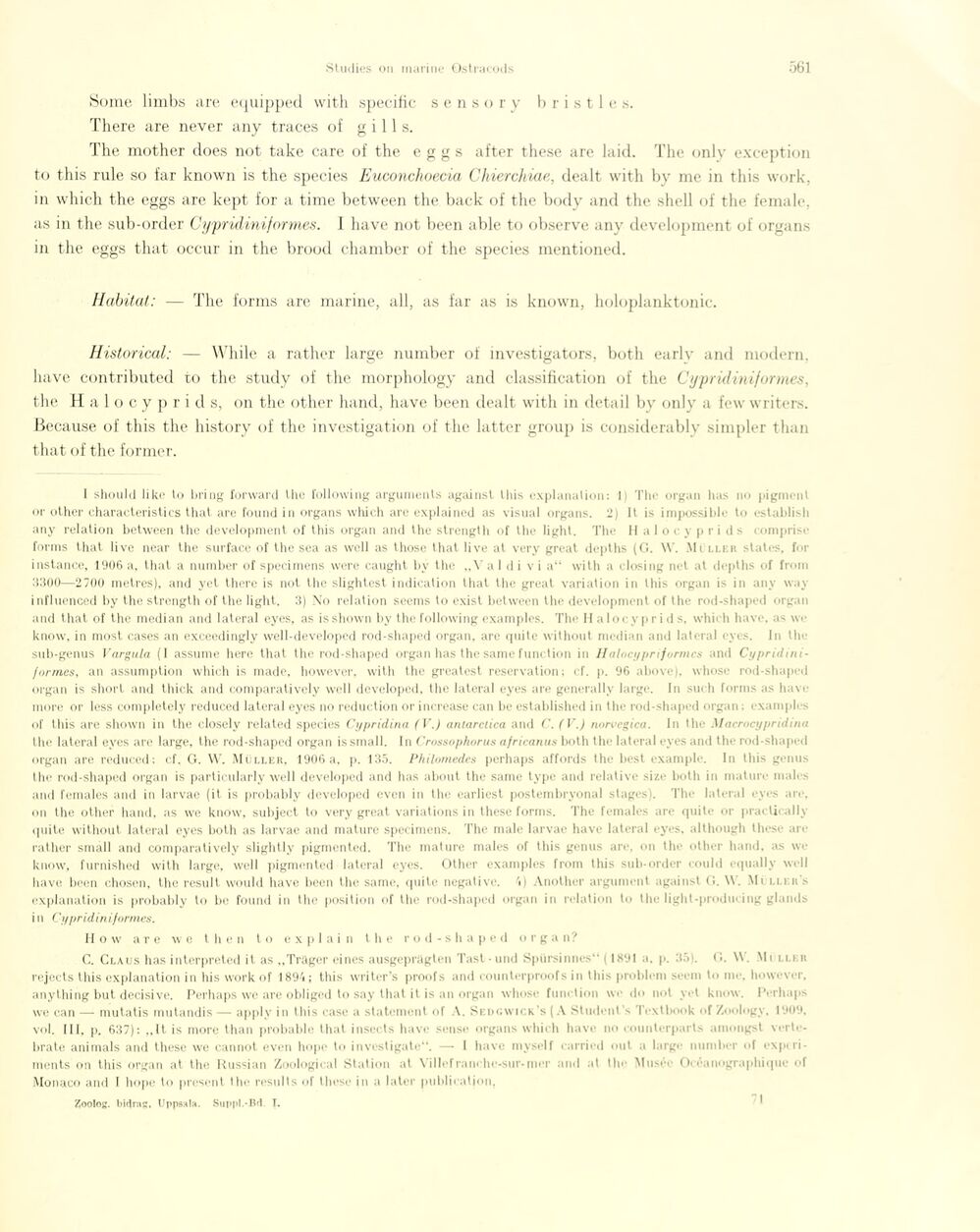
Full resolution (JPEG) - On this page / på denna sida - Sidor ...

<< prev. page << föreg. sida << >> nästa sida >> next page >>
Below is the raw OCR text
from the above scanned image.
Do you see an error? Proofread the page now!
Här nedan syns maskintolkade texten från faksimilbilden ovan.
Ser du något fel? Korrekturläs sidan nu!
This page has never been proofread. / Denna sida har aldrig korrekturlästs.
Some limbs are equipped with specific s e n s o r y b r i s 11 e s.
There are never any traces of g i 11 s.
The mother does not take care of the eggs after these are laid. The only exception
to this rule so far known is the species Euconchoecia Chierchiae, dealt with by me in this work,
in which the eggs are kept for a time between the back of the body and the shell of the female,
as in the sub-order Cypridiniformes. 1 have not been able to observe any development of organs
in the eggs that occur in the brood chamber of the species mentioned.
Habitai: — The forms are marine, all, as far as is known, holoplanktonic.
Historical: — While a rather large number of investigators, both early and modern.
have contributed to the study of the morphology and classification of the Cypridiniformes,
the Halocyprid s, on the other hånd, have been dealt with in detail by only a few writers.
Because of this the history of the investigation of the latter group is considérable simpler than
that of the former.
I should like to bring forward the following arguments against this cxplanation; 1) The organ has no pigment
or other characteristies that are found in organs which are explained as visual organs. 2) lt is impossible to establish
any relation between the development of this organ and the strength of the light. The Halo c y p ri d - comprise
forms that live near the surface of the sea as well as those that live at very great depths (G. W. Muller states, for
instance, 1906 a, that a number of specimens were caught by the „Y a 1 d i v i a“ with a closing net at depths of from
3300—2700 metres), and yet there is not the slightest indication that the great variation in this organ is in any way
influenced by the strength of the light. 3) No relation seems to exist between the development of the rod-shaped organ
and that of the median and lateral eyes, as is shown by the following examples. The Halocyprids, which have, as wc
know, in most cases an exceedingly weli-developed rod-shaped organ, are quite without median and lateral eyes. In the
sub-genus Vargula (1 assume here that the rod-shaped organ has the same funetion in Halocypriformes and
Cypridini-j ormes, an assumption which is made, however, with the greatest reservation; cf. p. 96 a bove), whose rod-shaped
organ is short and thick and comparatively well developed, the lateral eyes are generally large. In such forms as have
more or less completely reduced lateral eyes no réduction or inerease can be established in the rod-shaped organ ; examples
of tilis are shown in the closely related species Cypridina (V.) antarctica and C. (V.) norvegica. In the Macrocypridina
the lateral eyes are large, the rod-shaped organ is small. In Crossophorus africanus both the lateral eyes and the rod-shaped
organ are reduced; cf. G. W. Müller, 1906 a, p. 135. Philomecles perhaps affords the best example. In this genus
the rod-shaped organ is particularly well developed and has about the same type and relative size both in mature males
and females and in larvae (it is probably developed even in the earliest postembryonal stages). The lateral eyes are.
on the other hånd. as we know, subjeet to very great variations in these forms. The females are quite or praclically
quite without lateral eyes both as larvae and mature specimens. The male larvae have lateral eyes, although these are
rather small and comparatively slightly pigmented. The mature males of this genus are, on the other band, as we
know, furnished with large, well pigmented lateral eyes. Other examples from this sub-order rould equally well
have been chosen, the result would have been the same, quite negative, i) Another argument against G. W. Mi llkr s
explanation is probably to be found in the position of the rod-shaped organ in relation to thu light-prodm ing glands
in Cypridiniformes.
H o w are w e t h e n t o expiai il t h e r o d - s h a p e d o r g a n?
C. Claus has interpreted it as „Träger eines ausgeprägten Tast-und Spürsinnes" ( 1891 a. p. 3.. . (i. \\ Mi llkr
rejccts this cxplanation in his work of 1894; this writer’s proofs and counterproofs in this problem seem to me, however.
anything but decisive. Perhaps we are obliged to say that it is an organ whose funetion we do not yet know. Perhaps
we can — mutatis mutandis — apply in this case a statement of A. Sedgwick’s ( A Student - Textbook of Zoologe. 1909.
vol. III, p. 637): „lt is more than probable that insects have sense organs which have no counterparts amongst
verte-brate animais and these we cannot even hope to investigate“. — I have myself earried out a large number of
experiments on this organ at the Russian Zoological Station at Villefranehe-sur-mer and at the Musée Océanographique of
Monaco and I hope to present the results of these in a later publication,
Zoolog, bidrag, Uppsala. Suppl.-Bd. I.
<< prev. page << föreg. sida << >> nästa sida >> next page >>